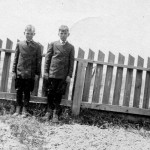
Do you collect old cookbooks, vintage Jell-O brochures, or comb-bound community cookbooks? I do. My kitchen shelves are filled with books instead of trendy decorative objects, but I like it that way. It feels a bit like a library that allows food and drink.
(You can read about my cookbook collecting in this post. And if you like cookbooks and heritage recipes, you might like to read my review of Gena Philibert Ortega’s new book From the Family Kitchen, too).
The only problem (well, not really a problem) with old cookbooks in the kitchen is that they are handled more often than books stashed away in archival boxes in a closet. I like to read and use my old cookbooks, but I also want to protect them from the usual “environmental hazards” like dust, etc. in the kitchen. I’ve been collecting old cookbooks for decades, and some were costly, so I want to protect my investment too.
How to Store Old Cookbooks
1. Look for cooking clues. The first thing I do when I bring home a new old cookbook is to examine the book for loose paper scraps and any items that may have been left between the pages. If they are damaging the page I remove the item or enclose it in rag paper and leave it where it was. I throw away any paper clips or metal.
Cooks often use whatever is at hand to mark a recipe in a book, and I like to see what pages other people might have found interesting. I also look for food stains, comments, and corrections that might indicate the popularity (or not) of a recipe.
2. Protect the cover. Next, I cover the book with an archival book cover. I first ordered an assortment of various sizes, 35 Brodart Just-A-Fold III Archival Book Covers – Sampler Pack , and have since purchased more covers in the sizes I use most often. I like the way the clear mylar covers keep the paper dust jackets clean and protect them from rips and tears. I also cover books that have lost their jackets to keep the cover clean.
3. Add to my catalog. I like to know what books I have in my cookbook collection so I can fill in the gaps with new treasures. I’ve used everything from a spreadsheet to a simple book collection database to list titles and subjects, but I’m now working on moving my catalog to an App I can view on my iPad and iPhone. After years of general cookbook collecting, I’m finding it’s even more fun to build up a special niche of old cookbooks.
4. Find a place on the shelf. Books are best stored upright on a shelf with other books of about the same size. They should be supported by books (or bookends) on either side so they don’t slump, slant, or lean and cause the binding to become stressed and bent. Avoid cramming so many books on the shelf that they are tight and difficult to remove. The spine of old books is often loose and weak, so it’s best to pull out a single volume by pushing back the books on either side until you can grasp the book by both front and back covers and then remove it from the shelf.
My kitchen bookshelves are located over a small built-in desk and away from direct sunlight, an important consideration for minimizing fading and light damage. Although I wouldn’t store my collection in a smoking zone, I’m not so conscientious about cooking odors. I burn the occasional piece of toast or over-crisp the bacon, but I figure my kitchen exhaust fan takes care of the bulk of the fumes.
I do have a few very special cookbooks that I keep on my living room shelves where they are better protected from light, odors, and handling. And, my small collection of Jell-O recipe pamphlets is housed in a suitably-sized archival box on the kitchen bookshelf. You never know when you might need a spectacular Jell-O recipe!
For more information on caring for old books see the Northeast Document Conservation Center:
NEDCC Preservation Leaflet 7.2 Surface Cleaning of Paper (including book pages).
NEDCC Preservation Leaflet 4.1 Storage Methods and Handling Practices (including books)
You bring up a good point, Karen, about how to handle those old recipe cards. I’ve planned a special post on just that topic for next week. Stay tuned!






Thank you. I have cookbooks that I received (and bought) in the 1960s and I was thinking that I needed to "downsize". Now I'll just keep them and enjoy looking through them. Of course, I haven't quite figured out what to do with about 40 inches of 3 x 5 cards with recipes on them. But that's another story. Again, thank you.